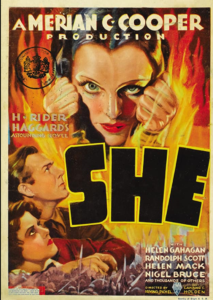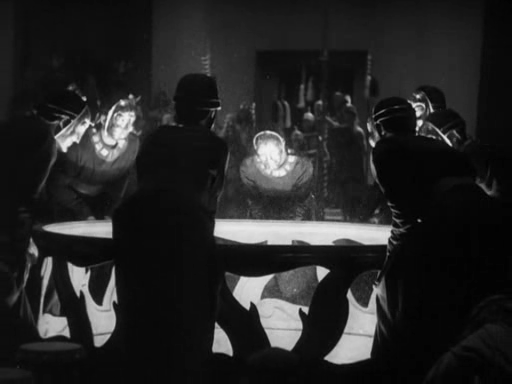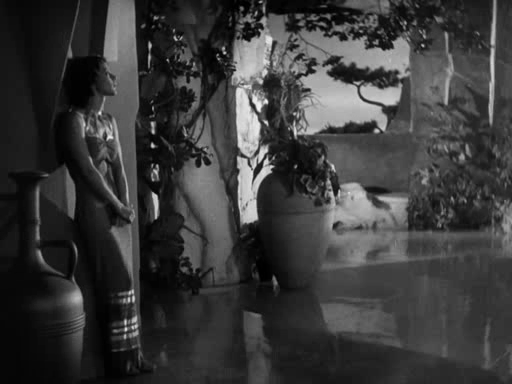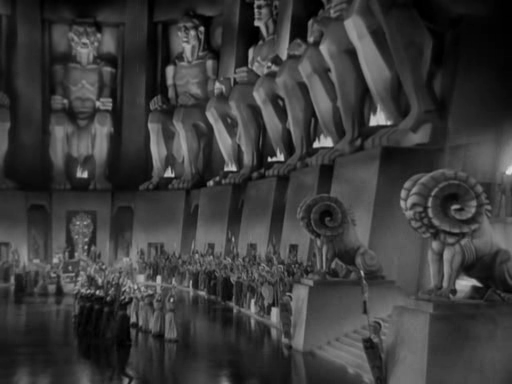“Dreams are only memories in the endless flow of time.”
|

Synopsis:
A young man (Randolph Scott) and a family friend (Nigel Bruce) travel to the Arctic to search for a hidden city said to possess the fire of immortality. Once they arrive, the city’s ruler, “She” (Helen Gahagan), recognizes Scott as her long-lost lover come to life, and is determined to steal him away from his new romantic interest (Helen Mack).
|
|
Genres, Themes, Actors, and Directors:
- Antarctica and the Arctic
- Fantasy
- Past Lives
- Randolph Scott Films
- Search
- Strong Females
Review:
Based on an oft-filmed novel by H. Rider Haggard (with most adaptions made during the silent film era, and most also called simply She), this “lost world” adventure flick was producer Merian C. Cooper’s follow-up to King Kong (1933). The transposition of Haggard’s original South African setting to the Arctic north allowed for the creation of some impressively baroque Art Deco sets (and ultimately isn’t too egregious of a shift, given that this was an equally “remote” and mysterious location for audiences at the time). Yet the film as a whole suffers from a serious lack of chemistry between its nominal “romantic leads”. Unlike in the 1965 Hammer Studios remake (starring Ursula Andress and John Richardson), we never once believe in the viability of Scott and Gahagan’s presumed centuries-old romantic connection. In the Andress/Richardson remake, Richardson “meets” Andress before setting out on his voyage of discovery, and feels a strong sensual attraction to her from the get-go; here, Scott merely seems befuddled and irritated in Gahagan’s presence, and anxious to get back to his “real world” love interest, Helen Mack. Not helping matters is Scott’s wooden acting, especially noticeable in contrast with Gahagan’s more theatrical approach to her role. While the visuals are worth a look (the cinematography and sets are quite stunning at times), this one is ultimately skippable.
Redeeming Qualities and Moments:
- J. Roy Hunt’s cinematography

- Enjoyably baroque sets


- Outrageous costumes (note the strong parallel here between Gahagan’s outfit and that of the queen in Disney’s animated Snow White, released just two years later)

Must See?
No; this one isn’t must-see unless you’re curious.
Links:
|
3 thoughts on “She (1935)”
Not a must.
I’d not seen this til now but, growing up, I’d seen producer Cooper’s magnificent ‘King Kong’ any number of times. As a follow-up to ‘KK’ – admittedly a very hard act to follow – this version of ‘She’ disappoints on various levels, but mainly by way of its clunky script loaded with silly dialogue.
I hope the original novel works better as an adventure story because this film, much like the 1965 version in its own erotic way, just comes off like much ado about nothing. As a film character, She is a rather uninteresting nemesis: she has nothing memorable to say and, contrary to what one might expect, holds no philosophical worldview; she’s without substantial – or even noticeable – power, yet her drone followers are ever-ready to throw anyone who opposes her into the nearest pit; she has a single, self-serving goal of being united with the ‘ideal’ love-slave who will remain at her side for what appears would be a very boring eternity.
As She, Gahagan (who, I’m surprised to learn, was married to Melvyn Douglas for almost 50 years) does her best with a soulless role. (How intriguing that “She who must be obeyed” would leave the film industry after this performance and enter politics!)
(I was rather tickled by one moment – when an incensed Gahagan almost seems to go off-script when Mack asks her for Scott’s release –
Gahagan: I’m taking nothing away from you that was ever yours. He’s been mine since– Why do I stand here talking with you?! Go now!)
Scott, who luckily got better in front of a camera as he went along, really is “wooden” here. As Professor Holly, Bruce (who would go on to be Dr. Watson in various Sherlock Holmes movies and appear notably in Hitchcock’s ‘Rebecca’ and ‘Suspicion’) does a credible job in his sidekick capacity.
Though the film kind of plods along sluggishly, things perk up considerably with a bizarre ritual-dance segment which begins when the film has approx. 20 minutes to go. If you do decide to watch this movie for any reason, let this be the one! It’s a blissfully extended sequence of nonsensical – at times Busby Berkeley-esque – gyrating which may (as you chuckle) make you ponder, ‘Gee, why doesn’t She demand more of *this* on a regular basis?!’
I’m developing an informal theory that a handful of cinematic clunkers over the years have been at least partially “redeemed” by the sudden introduction of “bizarre ritual-dance segments” near the end — viz. this film and Kurosawa’s The Lower Depths (1957), for instance… 😉
You may very well be on to something there. I’d be willing to concur that a considerable number of so-so films have been somewhat saved by some kind of sudden dance sequence (ritualistic or not). 😉